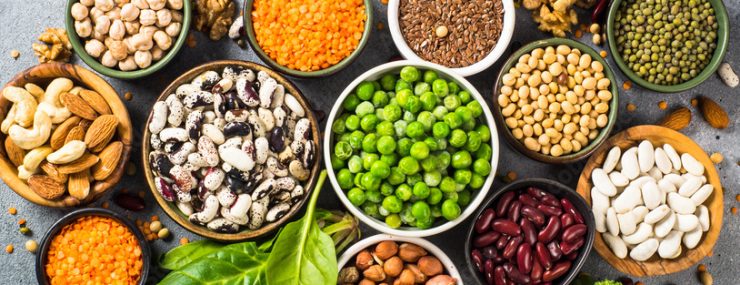The Fibre vs Protein Debate: Which Is More Important and Why?
Protein
- Chicken, turkey, fish, eggs, and dairy
- Plant-based sources like legumes, pulses, nuts, and seeds
Fibre
Fibre is an essential component of a healthy diet. It supports the growth of beneficial bacteria in the gut, which can boost immunity and reduce the risk of chronic diseases such as cardiovascular disease, type 2 diabetes, and bowel cancer.
Fibre is found in plant foods, and although it’s not digested by the small intestine, it gets fermented by bacteria in the large intestine. This process produces short-chain fatty acids (SCFAs), which help digest and absorb nutrients, protect against infections, and support a healthy gut microbiota.
Too Much Protein, Too Little Fibre
In the UK and Ireland, overconsumption of protein is common across all age groups and genders.
- Teens are consuming 29–70% more protein than recommended.
- Adults aged 19–74 exceed recommendations by 38–57%.
Meanwhile, most of us aren’t even meeting 60% of our recommended fibre intake.
This matters: bowel cancer is one of the top four most common cancers in the UK, and 28 in 100 cases (28%) are caused by eating too little fibre (Cancer Research UK, 2025).
Protein Is Important — But Be Mindful of the Source
With ultra-processed foods (UPFs) on the rise and big companies jumping on the protein bandwagon, supermarket shelves are now packed with “high-protein” products — from protein pancakes and yoghurts to popcorn and even water (yes, that’s a thing).
These products are often cleverly marketed to appear healthy, but they’re typically lower in fibre due to industrial processing. Many also contain higher levels of refined sugars and unhealthy fats, replacing more nutritious whole foods.
What About the Carnivore vs Plant Protein Debate?
Then there’s the other extreme: the carnivore diet, which promotes protein in its ‘truest’ form — thick cuts of steak and lean meats — with no room for fibre or dietary diversity.
Some influencers claim plant-based protein is “incomplete” or of “low biological value.” But research consistently shows that people who exclude meat and fish can still easily meet their protein needs.
Yes, plant-based foods generally contain less protein per gram than animal-based ones, but they:
- Provide complex carbohydrates
- Are lower in saturated fats
- Are an excellent source of fibre
Plant proteins do contain all the essential amino acids (EAAs) — and your body is smart. It can balance amino acid intake over the course of the day, so you don’t need to get everything in one meal.
The Bottom Line
Both protein and fibre are essential for good health — but together, they’re even more powerful.
They help:
- Keep you fuller for longer
- Reduce cravings
- Prevent overeating
- Regulate blood sugar levels
- Maintain stable energy throughout the day
My Advice
✅ Aim for 30g of fibre per day by adding to your current meals rather than restricting.
Try swapping white rice for brown rice, or upgrading your snacks — instead of a protein yoghurt, have Greek yoghurt topped with nuts and seeds.
✅ Spread your protein intake evenly across the day to optimise muscle building and overall health.
This looks like 20g of animal protein per meal, or 30g of plant protein per meal.
🚫 Don’t sleep on plant protein — it brings fibre to the party too.
Pro Tip: Variety Is Key
Combining plant and animal proteins can boost both fibre and protein in one go. Think: lentil and chicken curry, tofu stir-fry with egg, or a chickpea and tuna salad.

